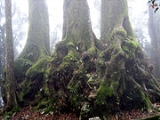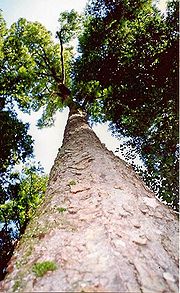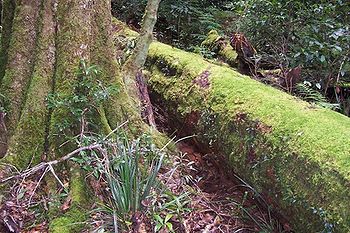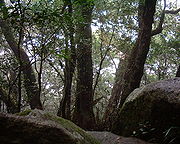
Nothofagus moorei
Encyclopedia
Nothofagus moorei, is an important Gondwana
relict
of the rainforest
s of the southern hemisphere. It occurs in wet, fire free areas at high altitude in eastern Australia
.
Once referred to as 'Negrohead beech', but now as 'Antarctic beech' (not to be confused with its South American relative, Nothofagus antarctica
) is an evergreen
tree native to the eastern highlands of Australia
.
s from the Barrington Tops plateau in New South Wales
, north to the Lamington Plateau and Springbrook Plateau, in southern Queensland
, between altitudes of 500 m and 1550 m. It occurs in temperate to cool temperatures and with occasional snowfalls. Nothofagus moorei achieves its finest development at Werrikimbe National Park
and Mount Banda Banda.
 These trees typically grow to 25 m tall and have large trunks to 1 m in diameter with scaly, dark brown bark. Maximum height is about 50 m. The leaves
These trees typically grow to 25 m tall and have large trunks to 1 m in diameter with scaly, dark brown bark. Maximum height is about 50 m. The leaves
are simple and alternate, growing six centimeters long. The leaf color is dark green, with new growth brilliant red, or orange in spring. The tree is partially deciduous, dropping half its leaves in autumn. They are triangular with fine teeth. The flower
s are inconspicuous yellow-green catkin
s. The fruit
, produced from December to February, are a capsule of four prickly valves containing three small winged nuts
.
Complicated root structures are frequently exhibited. These root
s would once have been soil
-covered, but have been exposed over the ages by erosion
, and covered in moss
and lichen
. Many of the trees have multiple trunks emanating from a crown, formed by this root structure. The tree regenerates easily after fires.
 Many individuals are extremely old, and at one time it was believed that the Eastern Australian populations could not reproduce in present-day conditions, except by sucker
Many individuals are extremely old, and at one time it was believed that the Eastern Australian populations could not reproduce in present-day conditions, except by sucker
ing (Asexual reproduction
), being remnant forest from a cooler time. It has since been shown that sexual reproduction
may occur, but distribution in cool, isolated high-altitude environments at temperate
and tropical latitude
s is consistent with the theory that the species was more prolific in a cooler age. The pattern of distribution
around the southern Pacific Ocean rim
has fed speculation that the dissemination of the genus dates to the time when Antarctica, Australia and South America
were connected, the theoretical common land-mass referred to as Gondwana
.
 It is an ornamental tree and cultivated specimens tolerate −7°C (19°F), though wild plants growing on Barrington Tops have withstood record low temperatures of −17°C (1°F), no source provenance have been selected from there and other mountains, highlands or plateaus for cultivation.
It is an ornamental tree and cultivated specimens tolerate −7°C (19°F), though wild plants growing on Barrington Tops have withstood record low temperatures of −17°C (1°F), no source provenance have been selected from there and other mountains, highlands or plateaus for cultivation.
Gondwana
In paleogeography, Gondwana , originally Gondwanaland, was the southernmost of two supercontinents that later became parts of the Pangaea supercontinent. It existed from approximately 510 to 180 million years ago . Gondwana is believed to have sutured between ca. 570 and 510 Mya,...
relict
Relict
A relict is a surviving remnant of a natural phenomenon.* In biology a relict is an organism that at an earlier time was abundant in a large area but now occurs at only one or a few small areas....
of the rainforest
Rainforest
Rainforests are forests characterized by high rainfall, with definitions based on a minimum normal annual rainfall of 1750-2000 mm...
s of the southern hemisphere. It occurs in wet, fire free areas at high altitude in eastern Australia
Australia
Australia , officially the Commonwealth of Australia, is a country in the Southern Hemisphere comprising the mainland of the Australian continent, the island of Tasmania, and numerous smaller islands in the Indian and Pacific Oceans. It is the world's sixth-largest country by total area...
.
Once referred to as 'Negrohead beech', but now as 'Antarctic beech' (not to be confused with its South American relative, Nothofagus antarctica
Nothofagus antarctica
Nothofagus antarctica , is a deciduous tree or shrub native to southern Chile and Argentina from about 36°S to Tierra del Fuego . The southernmost occurrence is on Hoste Island, making it the southernmost trees on earth...
) is an evergreen
Evergreen
In botany, an evergreen plant is a plant that has leaves in all seasons. This contrasts with deciduous plants, which completely lose their foliage during the winter or dry season.There are many different kinds of evergreen plants, both trees and shrubs...
tree native to the eastern highlands of Australia
Australia
Australia , officially the Commonwealth of Australia, is a country in the Southern Hemisphere comprising the mainland of the Australian continent, the island of Tasmania, and numerous smaller islands in the Indian and Pacific Oceans. It is the world's sixth-largest country by total area...
.
Habitat
It grows in cool temperate rainforestRainforest
Rainforests are forests characterized by high rainfall, with definitions based on a minimum normal annual rainfall of 1750-2000 mm...
s from the Barrington Tops plateau in New South Wales
New South Wales
New South Wales is a state of :Australia, located in the east of the country. It is bordered by Queensland, Victoria and South Australia to the north, south and west respectively. To the east, the state is bordered by the Tasman Sea, which forms part of the Pacific Ocean. New South Wales...
, north to the Lamington Plateau and Springbrook Plateau, in southern Queensland
Queensland
Queensland is a state of Australia, occupying the north-eastern section of the mainland continent. It is bordered by the Northern Territory, South Australia and New South Wales to the west, south-west and south respectively. To the east, Queensland is bordered by the Coral Sea and Pacific Ocean...
, between altitudes of 500 m and 1550 m. It occurs in temperate to cool temperatures and with occasional snowfalls. Nothofagus moorei achieves its finest development at Werrikimbe National Park
Werrikimbe National Park
Werrikimbe National Park is in the catchment zone of the Upper Hastings River, New South Wales, Australia, about 486 km north of Sydney. This national park is about 80 km west of Wauchope and 90 km east of Walcha on the eastern escarpment of the Great Dividing Range...
and Mount Banda Banda.
Characteristics

Leaf
A leaf is an organ of a vascular plant, as defined in botanical terms, and in particular in plant morphology. Foliage is a mass noun that refers to leaves as a feature of plants....
are simple and alternate, growing six centimeters long. The leaf color is dark green, with new growth brilliant red, or orange in spring. The tree is partially deciduous, dropping half its leaves in autumn. They are triangular with fine teeth. The flower
Flower
A flower, sometimes known as a bloom or blossom, is the reproductive structure found in flowering plants . The biological function of a flower is to effect reproduction, usually by providing a mechanism for the union of sperm with eggs...
s are inconspicuous yellow-green catkin
Catkin
A catkin or ament is a slim, cylindrical flower cluster, with inconspicuous or no petals, usually wind-pollinated but sometimes insect pollinated . They contain many, usually unisexual flowers, arranged closely along a central stem which is often drooping...
s. The fruit
Fruit
In broad terms, a fruit is a structure of a plant that contains its seeds.The term has different meanings dependent on context. In non-technical usage, such as food preparation, fruit normally means the fleshy seed-associated structures of certain plants that are sweet and edible in the raw state,...
, produced from December to February, are a capsule of four prickly valves containing three small winged nuts
Nut (fruit)
A nut is a hard-shelled fruit of some plants having an indehiscent seed. While a wide variety of dried seeds and fruits are called nuts in English, only a certain number of them are considered by biologists to be true nuts...
.
Complicated root structures are frequently exhibited. These root
Root
In vascular plants, the root is the organ of a plant that typically lies below the surface of the soil. This is not always the case, however, since a root can also be aerial or aerating . Furthermore, a stem normally occurring below ground is not exceptional either...
s would once have been soil
Soil
Soil is a natural body consisting of layers of mineral constituents of variable thicknesses, which differ from the parent materials in their morphological, physical, chemical, and mineralogical characteristics...
-covered, but have been exposed over the ages by erosion
Erosion
Erosion is when materials are removed from the surface and changed into something else. It only works by hydraulic actions and transport of solids in the natural environment, and leads to the deposition of these materials elsewhere...
, and covered in moss
Moss
Mosses are small, soft plants that are typically 1–10 cm tall, though some species are much larger. They commonly grow close together in clumps or mats in damp or shady locations. They do not have flowers or seeds, and their simple leaves cover the thin wiry stems...
and lichen
Lichen
Lichens are composite organisms consisting of a symbiotic organism composed of a fungus with a photosynthetic partner , usually either a green alga or cyanobacterium...
. Many of the trees have multiple trunks emanating from a crown, formed by this root structure. The tree regenerates easily after fires.
History

Basal shoot
A basal shoot, root sprout, adventitious shoot, water sprout or sucker is a shoot or cane which grows from a bud at the base of a tree or shrub or from its roots. This shoot then becomes, or takes the form of, a singular plant. A plant that produces suckers is referred to as surculose...
ing (Asexual reproduction
Asexual reproduction
Asexual reproduction is a mode of reproduction by which offspring arise from a single parent, and inherit the genes of that parent only, it is reproduction which does not involve meiosis, ploidy reduction, or fertilization. A more stringent definition is agamogenesis which is reproduction without...
), being remnant forest from a cooler time. It has since been shown that sexual reproduction
Sexual reproduction
Sexual reproduction is the creation of a new organism by combining the genetic material of two organisms. There are two main processes during sexual reproduction; they are: meiosis, involving the halving of the number of chromosomes; and fertilization, involving the fusion of two gametes and the...
may occur, but distribution in cool, isolated high-altitude environments at temperate
Temperate
In geography, temperate or tepid latitudes of the globe lie between the tropics and the polar circles. The changes in these regions between summer and winter are generally relatively moderate, rather than extreme hot or cold...
and tropical latitude
Latitude
In geography, the latitude of a location on the Earth is the angular distance of that location south or north of the Equator. The latitude is an angle, and is usually measured in degrees . The equator has a latitude of 0°, the North pole has a latitude of 90° north , and the South pole has a...
s is consistent with the theory that the species was more prolific in a cooler age. The pattern of distribution
Species distribution
Species distribution is the manner in which a biological taxon is spatially arranged. Species distribution is not to be confused with dispersal, which is the movement of individuals away from their area of origin or from centers of high population density. A similar concept is the species range. A...
around the southern Pacific Ocean rim
Pacific Rim
The Pacific Rim refers to places around the edge of the Pacific Ocean. The term "Pacific Basin" includes the Pacific Rim and islands in the Pacific Ocean...
has fed speculation that the dissemination of the genus dates to the time when Antarctica, Australia and South America
South America
South America is a continent situated in the Western Hemisphere, mostly in the Southern Hemisphere, with a relatively small portion in the Northern Hemisphere. The continent is also considered a subcontinent of the Americas. It is bordered on the west by the Pacific Ocean and on the north and east...
were connected, the theoretical common land-mass referred to as Gondwana
Gondwana
In paleogeography, Gondwana , originally Gondwanaland, was the southernmost of two supercontinents that later became parts of the Pangaea supercontinent. It existed from approximately 510 to 180 million years ago . Gondwana is believed to have sutured between ca. 570 and 510 Mya,...
.


